Petroleum - Introduction, Properties, Uses, Facts, FAQs
Petroleum is also known as “Black Gold” and the name itself indicates its importance to human’s daily life. Petroleum is utilised to form different products like plastics, gasoline, synthetic fabrics, etc. Due to
this reason petroleum is also referred to as the mother of all commodities.
What is Petroleum?
Petrol meaning (petrol name)
“Petra” is a Greek word and “Oleum” is a Latin word that means “rock oil” is used to derive the word petroleum. When it is drilled from the underground in the liquid form, it is called crude oil.
Crude oil meaning (what is the meaning of crude oil)
Crude oil is a naturally occurring petroleum oil that is composed of hydrocarbon derivatives and other organic materials. Crude oil, basically a type of fossil fuel, is refined to produce usable products including gasoline, diesel, and various other forms of petrochemicals. It is a non-renewable resource, i.e., it can't be replaced naturally at the rate we use it and therefore, a limited resource.
Example of Crude oils:
| TYPES | PROPERTIES | EXAMPLE |
| Very light oils | very volatile, evaporating within a few days. As a result, their toxicity levels also evaporate. | Gasoline, Jet Fuel, Kerosene, Petroleum Ether, Petroleum Naphtha, and Petroleum Spirit. |
| Light oils | moderately volatile and toxic. | Grade 1 and Grade 2 Fuel Oils and Diesel Fuel Oils as well as Most Domestic Fuel Oils |
| Medium oils | Medium oils have low volatility. They have higher viscosity as compared to light oils. It leads to higher toxicity which negatively impacts the environment. | Petroleum oil and paraffin oil |
| Heavy fuel oils | most viscous and least volatile. Hence, most toxic | Heavy fuel oils are grades 3,4,5 and 6. Fuel oils and heavy marine fuels are other examples. |
Petrol images are shown below.
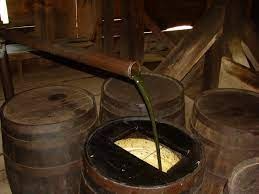

The Basic Constituents of Petroleum:
Carbon 84-87%, Hydrogen 11-14%, Sulfur 0.06-2%, Nitrogen 0.1-2%, Oxygen 0.1-0.2%, Metals 0-0.14%.
Also read -
- NCERT Solutions for Class 11 Chemistry
- NCERT Solutions for Class 12 Chemistry
- NCERT Solutions for All Subjects
NEET 2025: Mock Test Series | Syllabus | High Scoring Topics | PYQs
JEE Main: Study Materials | High Scoring Topics | Preparation Guide
JEE Main: Syllabus | Sample Papers | Mock Tests | PYQs
- What is Petroleum?
- Different Types of Petroleum Products
- How is Petroleum Formed?
- Definition of Petroleum Refinery
- Purification of Petroleum
- Importance of Petroleum
- What are Petrochemicals?
The chemical formula for petrol (petrol formula/petrol molecular formula )
Typical petroleum is a mixture of different chemicals such as paraffin, olefins, and naphthalene. Petrol has a basic chemical formula since it is a mixture of various chemicals and is also blended as per its requirement. So, its general petrol chemical formula is CnH2n+2.
Properties of Petroleum (characteristics of petroleum)
Petroleum oil appears as very fluid, volatile liquids and also viscous, semisolid materials. The colour of the oil is mainly black or greenish-black tinge in colour but sometimes you can observe that the colour is reddish, light yellow, greenish oil is black in colour, or black with a greenish tinge in colour. Sometimes it can be transparent, light yellow, greenish-yellow in colour.
Petroleum oil majorly contains cyclohexanes, alkanes, aromatic hydrocarbons, and other complex hydrocarbons like asphaltenes. The two main constituents of petroleum are carbon and hydrogen.
The properties of petroleum oil may vary extensively. Heavier fractions like asphaltene contain more metal concentrations than saturated and aromatic fractions. Apart from this sulphur and nitrogen are present in traces in light petroleum.
Different Types of Petroleum Products
Different types of petroleum products are gasoline, liquified natural gas, liquified petroleum gas, kerosene, butane, fuel oil, diesel fuel, propane, paraffin wax, petroleum jelly, microcrystalline wax, etc.
How is Petroleum Formed?
Origin of oil
Petroleum is formed from the remains of dead plants (diatoms) such as algae and zooplankton and animals after being decayed by decomposers.
When plants and animals died millions of years ago they settled on the seabed. These dead plants and animals decomposed and mixed with sand.
Decomposition of the organic matter is done by bacterias which lead to a chemical reaction.
After decomposition, the matter having a large amount of carbon and hydrogen is left behind. Due to a deficiency of oxygen at the bottom of the sea, matter does not decompose completely. These partially decomposed organic substances remained on the seabed and eventually were covered with different layers of silt and sand.
The whole process took several million years and as a result of high temperature and pressure, the organic matter completely gets decomposed to form oil. The oil formed is known as crude oil.
Where is Crude oil Found?
crude oil—is a fossil fuel and found in large quantities beneath the Earth's surface; under multiple layers of slit of the seabed. It is of foul smell, yellowish black liquid. Crude oil is present in the underground areas known as reservoirs.
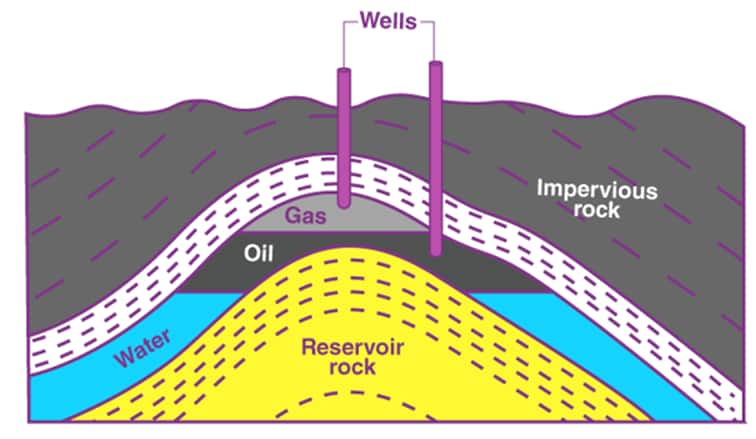
Petroleum refining process (describe the process of formation of petroleum).
An oil refinery or petroleum refining is an industrial manufacturing process, where crude oil is extracted and converted into more valuable goods, such as petroleum naphtha, gasoline, jet fuel, asphalt foundation, heating oil, petroleum kerosene, and liquefied gas. Oil refineries are huge industrial systems containing pipelines that hold fluid streams. The entire process is shown in a simple flowchart below:
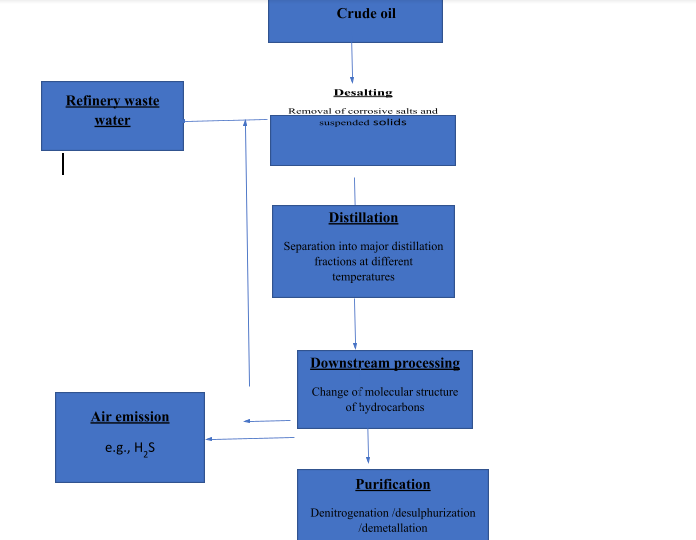
Different constituents of petroleum like gas, diesel, kerosene, etc. have different properties, therefore it is important to separate them. The process of separating different constituents of petroleum is referred to as petroleum refinery.
Definition of Petroleum Refinery
The separation of different constituents of petroleum is done in oil refineries in three steps.
In the initial stage, the crude oil is separated into its different components by the distillation process. The heavier constituents settle at the bottom and the lighter constituents rise up as vapour, or float in the liquid.
In the second step, the constituents are converted into gas, gasoline, and diesel. This step is known as conversion.
The last step known as treating the impurities is treated to obtain different products.
Petroleum Extraction (separation of petroleum)
The most common way of separating oil into different components (called fractions) is to do it using the boiling temperature differences. In petroleum refining, the method of separation used is “fractional distillation”.
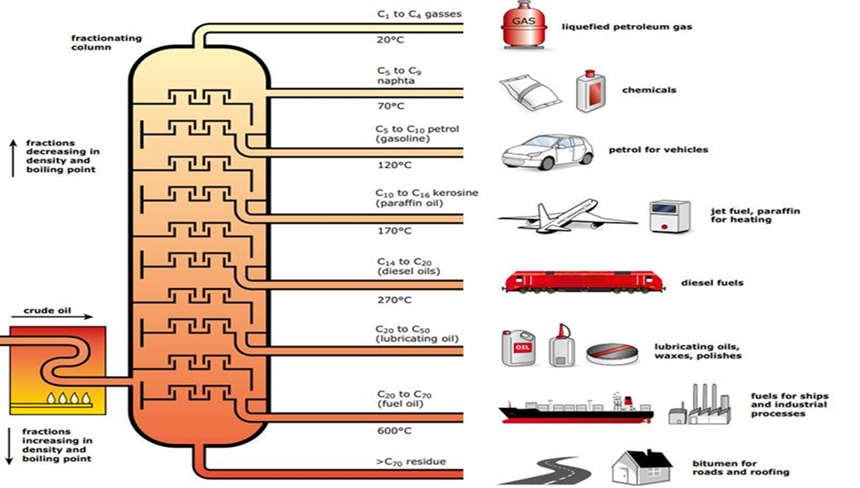
New methods, called conversion, use Chemical processing on certain fractions to produce others. For example, different chemical processing may split lengthier chains into shorter chains. This allows converting diesel fuel into gasoline, depending on the gasoline demand.
Also Read:
- NCERT solutions for Class 11 Chemistry Chapter 13 Hydrocarbons
- NCERT Exemplar Class 11 Chemistry Solutions Chapter 13 Hydrocarbons
- NCERT notes Class 11 Chemistry Chapter 13 Hydrocarbons
Purification of Petroleum
In industry, the refining process is usually called the “downstream” sector, while the “upstream” sector is called the raw crude oil output.
Petroleum refineries in India (crude oil refinery in India)
Gujrat (Jamnagar), Kerala (Kochi), Karnataka, Odisha, Haryana, Maharashtra (Bombay high), Punjab, Tamil Nadu, Assam (Digboi), West Bengal (Haldia).
Few Petrol Industries of India
Petroleum or mineral oil is India’s 2nd biggest source of energy after coal which supplies heat and lighting power, machinery lubricants, and raw materials in different manufacturing industries. Petroleum oil refineries for synthetic textiles, fertilisers, and various chemical industries act as a “nodal industry”. Most of India’s petroleum is found under the anticlines, or domes, where oil is trapped in the unfolding crest along with natural gas.
petroleum shares
Importance of Petroleum
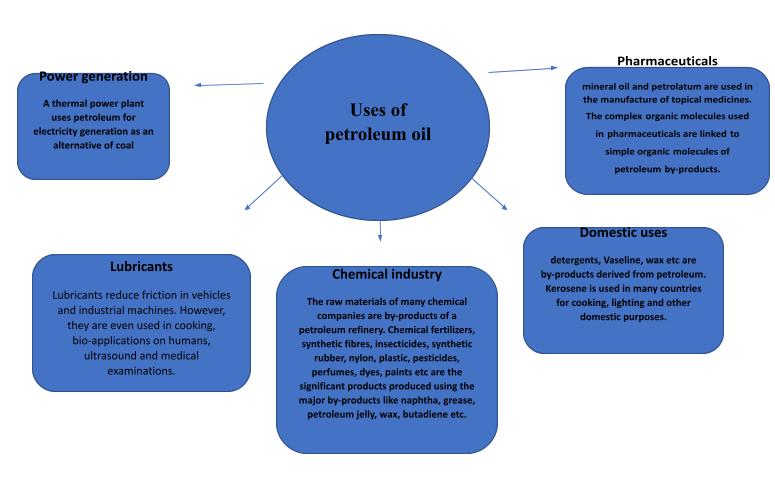
What are Petrochemicals?
Petrochemicals are the combination of different chemical compounds which are formed from hydrocarbons that are extracted from petroleum.
Also check-
- NCERT Exemplar Class 11th Chemistry Solutions
- NCERT Exemplar Class 12th Chemistry Solutions
- NCERT Exemplar Solutions for All Subjects
NCERT Chemistry Notes:
Frequently Asked Questions (FAQs)
Petrochemicals are chemical compounds that are derived from natural gas and petroleum.
Gasoline is a transparent flammable liquid utilized as a fuel. It consists majorly of organic compounds which are obtained by the fractional distillation of petroleum oil.
Petroleum is found under the seabed which is formed when large quantities of dead organisms are buried under sedimentary rock and subjected to temperature and pressure for million years.
Gujrat (Jamnagar), Kerala (Kochi), Karnataka, Odisha, Haryana, Maharashtra (Bombay high), Punjab, Tamil Nadu, Assam (Digboi), West Bengal (Haldia).
In 1847, the Scottish chemist James Young discovered petroleum.
The general petrol chemical formula is CnH2n+2.
Crude oil processing for use for different purposes.
Also Read
02 Jul'25 07:16 PM
02 Jul'25 07:16 PM
02 Jul'25 07:16 PM
02 Jul'25 07:15 PM
02 Jul'25 07:15 PM
02 Jul'25 07:14 PM
02 Jul'25 07:14 PM
02 Jul'25 07:14 PM
02 Jul'25 07:14 PM
02 Jul'25 07:13 PM
Articles
Questions related to
Hello Nanditha krishana,
Both the fields are valuable, but Computer Science Engineering (CSE) offers better career opportunities and career advancement in today's digital era. Since AI, data science, cybersecurity, and software development are fast-growing, Computer science skills are in highest demand globally across industries. Conversely, Petroleum Engineering is more specialized and connected to the oil and gas industry, which can be lucrative but is also subject to volatile global energy needs and environmental trends toward cleaner energy.
Therefore, if you seek flexibility, creativity, and a booming industry, CSE is the better option for the future. Nevertheless, the optimal path always relies on your own interest and career aspirations.
How to Complete a Petroleum Engineering Degree?
1. Degree Options:
B.Tech/B.E. (4 years) | Diploma (3 years) | M.Tech (2 years)
2. Eligibility :
B.Tech: 10+2 with PCM
Diploma: 10th with Science & Math
M.Tech: B.Tech in Petroleum or related field
3. Entrance Exams :
JEE Advanced/Main (For IITs, NITs)
State CETs & Private University Exams
4. Top Colleges :
IIT (ISM) Dhanbad, RGIPT Amethi, PDEU Gujarat, UPES Dehradun
5. Career Opportunities :
Oil & Gas Companies – ONGC, IOCL, BPCL, Shell, Reliance
Hello,
Regarding your query, the placement status of B.Tech in Petroleum Engineering is generally good, where many students secure jobs in oil and gas sector, with an average salary packages ranging from 6 to 10 LPA.
Hi Renimol,
Applying for petroleum engineering abroad involves several steps, from selecting the right university to completing the application and securing your admission. Here's a detailed guide:
1. Research Programs and Universities
Look for universities known for their petroleum engineering programs. Countries like the United States, Canada, the United Kingdom, Norway, Australia, and UAE are popular destinations.
Use platforms like QS World University Rankings or US News Rankings to identify universities with strong engineering faculties.
2. Understand Admission Requirements
Each university has specific requirements, but commonly you’ll need:
Academic Qualifications:
A strong background in mathematics, physics, and chemistry is essential. For master’s programs, a bachelor’s degree in engineering or a related field is required.
Standardized Tests:
For undergraduate: SAT or ACT scores.
For postgraduate: GRE (if required by the institution).
Language Proficiency:
English-taught programs require scores in TOEFL or IELTS.
Other certificates accepted may include PTE or Duolingo English Test in other universities.
3. Application Documents Preparation
Academic transcript and degree certificates.
Statement of Purpose which clearly indicates your interest in pursuing petroleum engineering.
Letters of recommendation from teachers or professionals with knowledge about your area of interest.
A
CV/Resume
detailing your relevant work experience, internship, or projects.
Financial documents when applying for scholarships or student loans.
4. Applying Through the Right Channels
Undergraduate Programs: Use application portals like Common App (USA) or
UCAS
(UK). Other countries, such as Canada and Australia, have separate applications for each university.
Postgraduate Programs: Apply directly through the university's website or centralized portals like
Studielink
(Netherlands) or
DAAD
(Germany).
5. Scholarships and Funding
Scholarships to look for:
Fulbright Scholarships (USA).
Commonwealth Scholarships (UK).
DAAD Scholarships (Germany).
University-specific grants or bursaries.
Some countries also offer government scholarships for international students.
6. Student Visa
Once admitted, apply for the student visa of the target country.
Prepare for Visa Interviews (if required), proof of financial support, Admission letters, and health insurance.
7. Preparation for Life Abroad
Secure accommodation and flights.
Understand the expectations of the culture and academic practices of your destination.
Best Petroleum Engineering Universities
Stanford University (USA)
Imperial College London (UK)
University of Alberta (Canada)
University of Texas at Austin (USA)
Norwegian University of Science and Technology (NTNU) (Norway)
Dear
According to the information Dibrugarh University's B.Tech in Petroleum Engineering requires a minimum of 45% in 10+2 exams with Physics, Chemistry, and Mathematics and a valid JEE Mains score. Since your JEE Mains percentile is 58 , you meet the minimum criteria for eligibility.
For more information you can read the official notification here .
Thanks.

